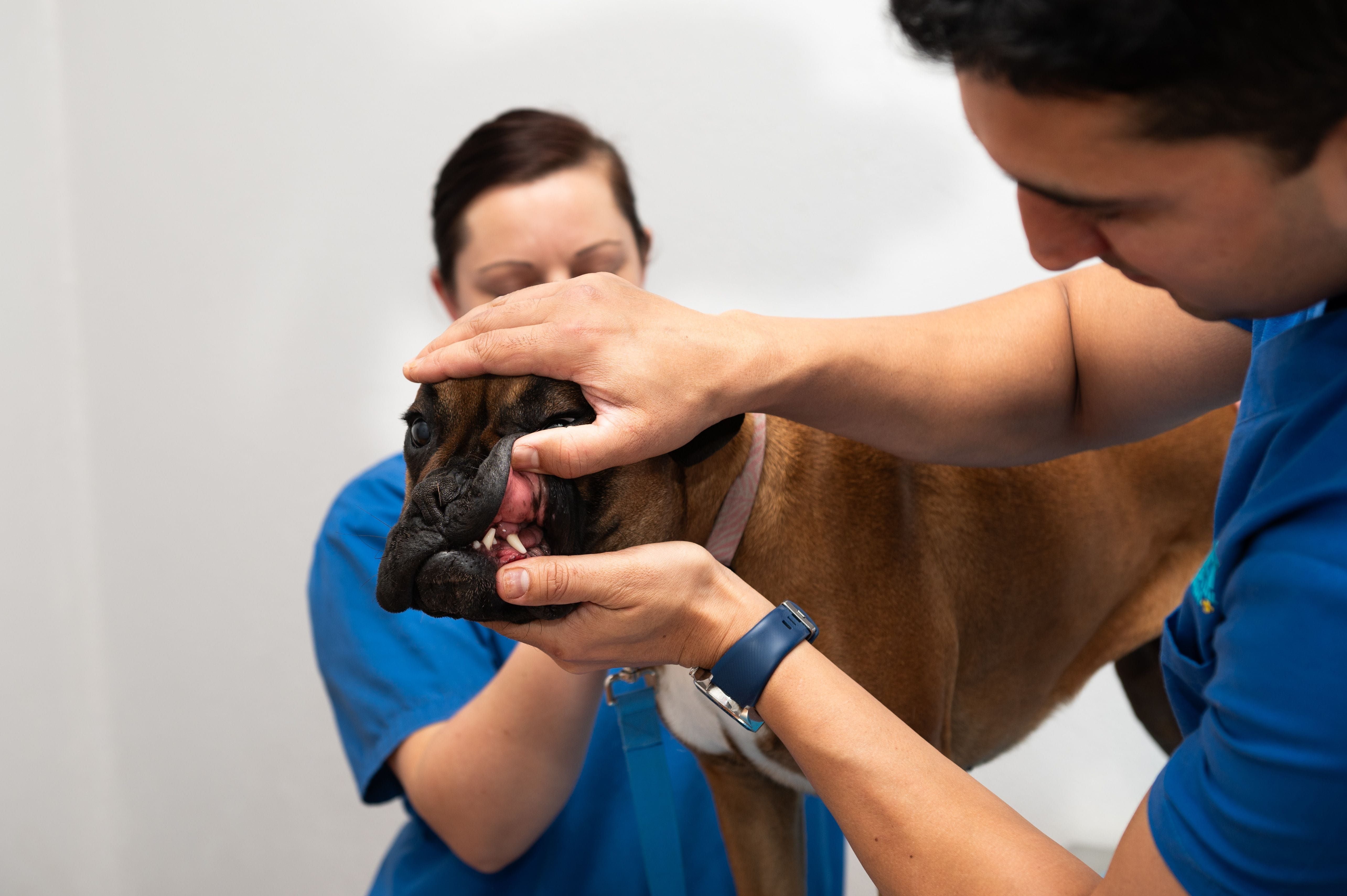Dental Disease in Dogs and Cats
)
Dental disease is very common among our pets, with it being reported that up to 80% of dogs and cats will have some form of dental disease by the age of 3!
What is dental disease?
Dental disease is formed by the accumulation of plaque which develops when bacteria in the mouth forms a biofilm on surface of the tooth which over time will become mineralised to form tartar. This leads to gingivitis - inflammation of the gums, which if left untreated can spread to the surrounding structures including the periodontal ligament (which holds the tooth in place) and even the bone. This results in pain, tooth loss, infection and abscesses of the tooth root and even jaw fracture. As the mouth has such a good blood supply it is even possible for this infection to spread via the bloodstream to organs such as the heart and
kidneys.
What are the signs of dental disease?
- Bad breath
- Tooth discolouration or visible tartar
- Red gums
- Missing teeth
- Salivating
- Quiet demeanour
- Difficulty eating or preference for soft food (although often the signs of pain are very subtle and dogs with quite severe dental disease often continue to eat)
What can we do about it?
Prevention of dental disease starts with puppies and kittens. At your puppy/kitten check ups and annual vaccinations your pets’ teeth will be assessed for factors which may predispose them to dental disease including problems with jaw alignment or retained deciduous (baby) teeth. At this age it is also ideal to start getting your puppy or kitten used to you checking their teeth and introducing brushing to their daily routine - making it a fun and positive experience for them.
You have an adult or older pet? Don’t worry there is still plenty you can do to help manage their teeth and it is often possible to introduce brushing later in life. We recommend starting with a dental assessment by one of our vets to ensure there is no pre-existing dental disease. If so this should be managed first to ensure that your pets mouth is pain free so as not to establish any negative associations with the brushing experience.
Prescription dental diets are also beneficial in minimising the development of dental disease. They do this by being abrasive to the surface of the tooth to reduce plaque build up and importantly they also contain a component that competes with bacteria in the mouth to bind to the tooth, minimising plaque formation.
In situations where plaque build up and tartar formation is already present a dental procedure will be required to clean the teeth and in some cases extraction of teeth with more advanced stages of disease will be required.
What does a dental procedure involve?
A dental procedure requires a full general anaesthetic to allow us to thoroughly clean and examine the teeth, including probing and x-ray assessment. This allows us to identify even subtle signs of disease which helps us to determine a treatment plan. Cleaning the teeth includes cleaning under the gum line as this is where bacteria can accumulate and start to invade the tooth root, periodontal ligament and surrounding bone. In the early stages a scale and polish of the teeth may be all that is required.
In more advanced stages extractions may be required. As many of the teeth have multiple roots and are surrounded by the jaw bone often surgical extractions are required. Prior to extraction the patient will receive nerve blocks with local anaesthetic for pain management and will go home with continuing pain relief. We often find that patients requiring extractions are feeling more comfortable quickly after the procedure as the source of discomfort has been removed.
Do you have an older pet with dental disease, but worried about the anaesthetic required for treatment? Already so common, dental disease becomes more prevalent in the older population of cats and dogs. This means performing dental procedures on these patients is something we do frequently. This doesn’t mean it is risk free, however we have multiple ways to manage and
minimise the risks to your pet so that we can perform the procedure and make them more comfortable and increase their longevity. Not performing a dental when required also carries risks; progression of disease with spread of infection both to surrounding bone and distant organs and significant pain which can stop them eating, cause weight loss and negatively impact on their quality of life.
Ways we minimise risk;
- Performing a thorough physical examination and pre-anaesthetic bloods to identify any underlying conditions - this allows us to tailor the anaesthetic protocol to the specific needs of the patient
- High level of patient monitoring (with technology which would not be out of place in human hospitals)
- Utilisation of anaesthetic sparing techniques - meaning we provide a high level of pain relief and use multiple different types of anaesthetic agents in order to minimise the doses required - Intravenous fluids throughout the anaesthetic to help support blood pressure
- Dedicated staff monitoring the patient closely throughout the procedure and recovery. Once your pet has recovered from the procedure you can continue with home care including brushing and dental diets in order to reduce the build up of plaque and the frequency for further intervention in the future.
Do you want your pets’ teeth assessed? Book an appointment today to see one of our friendly vets.
| Tags:Client Information |
